How to Manage Domain Admin and Tech Contact Details
Domain contact information includes the name, address, email, and phone number of individuals responsible for a domain. In this guide, we'll walk you through how to manage domain admin and tech contact details that ICANN requires for domain ownership verification, renewal notifications, security compliance, and technical issue resolution.
Understanding Domain Contacts and Permissions
Every domain has a Domain Owner, who holds legal authority over the domain and manages permissions for associated domain contacts. These contacts are listed in the Registration Data Directory Services (RDDS), formerly the WHOIS, and recognized by ICANN as authorized representatives. Keeping registrant details up to date is essential, especially for domain transfers.
In the Domain Contacts section, you will see the following:
- Domain Contacts - Personal information registered to the customer's domain name. The customer can manage the Admin and Tech contacts.
Need help updating and verifying the domain owner (registrant) contact details? See our guide: How to Update Domain Owner Contact Details.
- Domain Privacy + Protection - An encrypted version of the domain contact's information will be visible on the Registration Data Directory Services (RDDS), formerly WHOIS, shown on the right side, indicating the customer's private domain name. You can toggle to turn on and off by following the steps.
Domain Contacts and Permissions
| Permissions | Owner | Admin | Tech |
| Approve any transfers for the domain name | |||
| Change and appoint domain contacts | |||
| Maintain and update the Domain Nameservers (DNS) | |||
| Make changes without permission from the domain owner | |||
| Manage domain name settings | |||
| Receive notifications regarding the domain name expiration | |||
| Responsible for the payment of the domain name renewal | |||
| Right to use, sell, or destroy a domain name |
Managing Domain Admin and Tech Contact Details
To update the domain contact details:
- Log in to your Bluehost Account Manager.
- In the left-hand menu, click Domains.
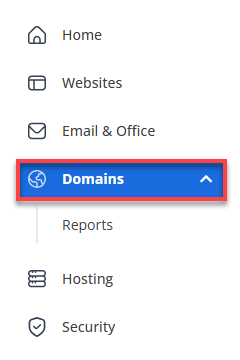
- If you have one domain in your account, you will be taken directly to the domain management panel.
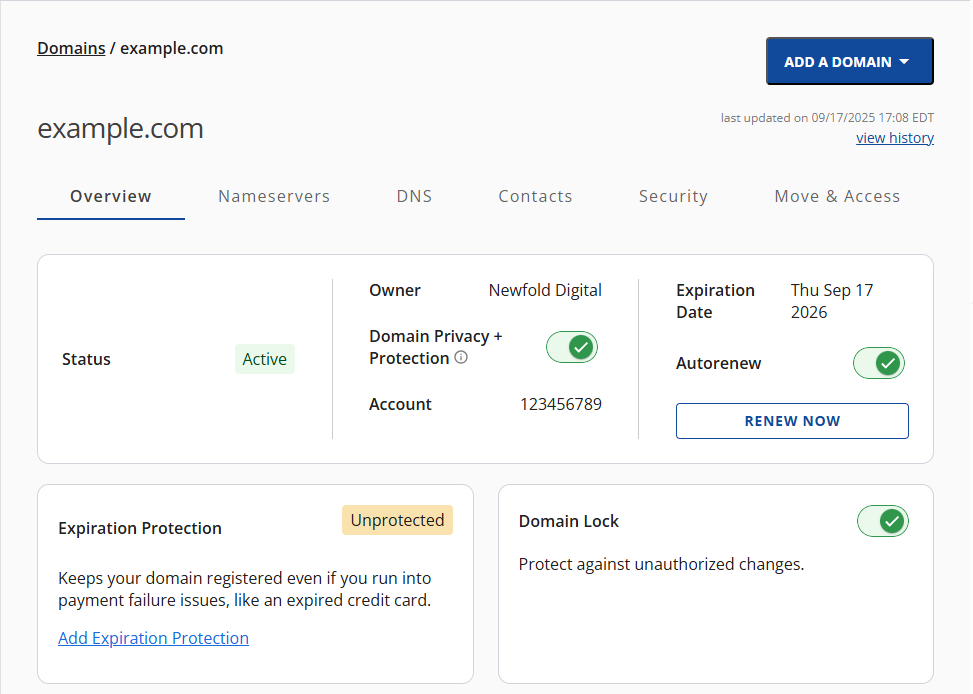
- If you have multiple domains in your account, click the domain you wish to manage to access the domain management panel.
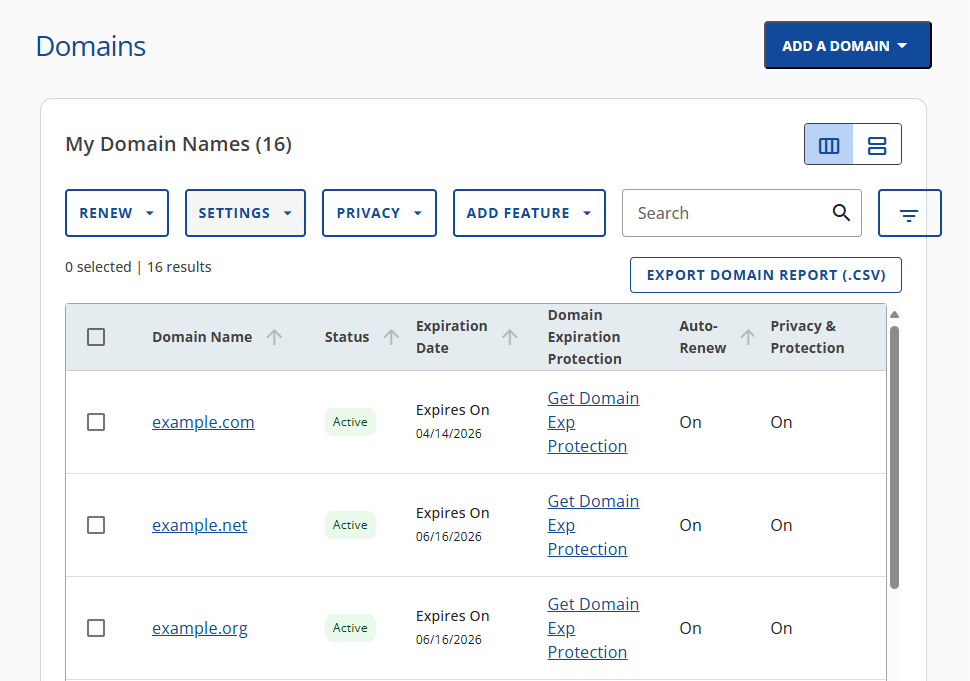
- If you have one domain in your account, you will be taken directly to the domain management panel.
- Go to the Contacts section.

- Click the Manage Admin and Tech Contacts link to add or edit the domain contact.
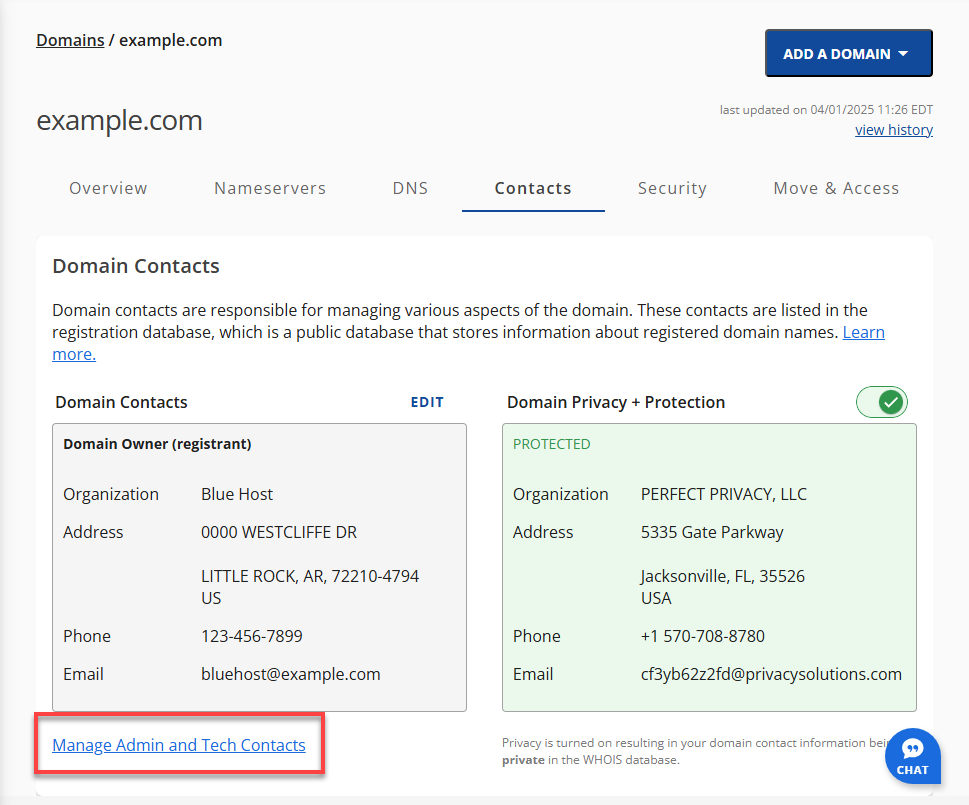
- Choose the contact type (Admin or Tech). From here, you can:

Add a New User (Admin or Tech)
- Click on the Change button to add the domain contacts.
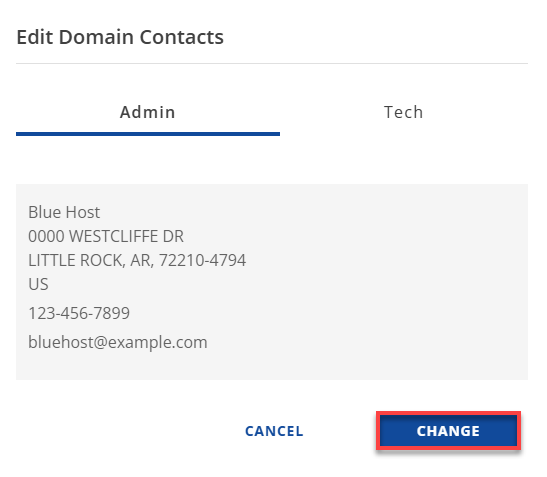
- Toggle between the Admin and Tech tab.
- Click the Add new link.

- In the Add New User pop-up, invite a new user to your account to become a domain contact by entering their Name and Email Address.
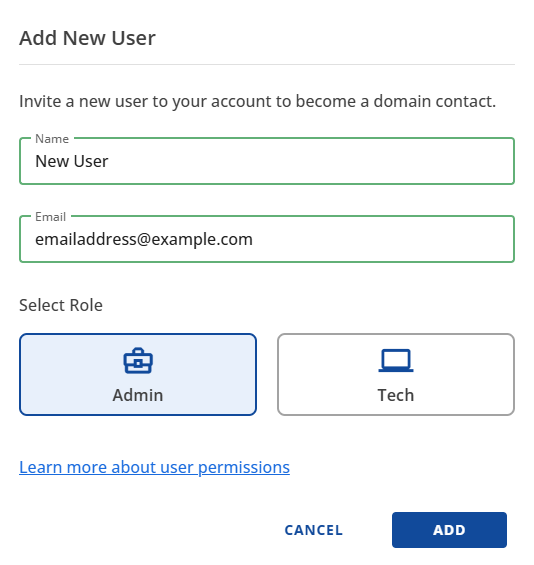
- Choose the Role (Admin or Tech) based on the permissions required.
- Click ADD to save your changes.
Add an Existing User
- Click Change in the Contacts section.

- Select an existing user from the dropdown.

- Update the information, and then click Save to update contact details.
Managing Domain Privacy Protection
Domain privacy protection is an essential service for website owners that helps safeguard personal information from public view. By managing this feature, you can decide when to enable or disable it, ensuring that your sensitive data remains secure while maintaining your online presence.
Enabling Domain Privacy Protection
Domain Privacy Protection ensures personal information remains hidden in the public Registration Data Directory Services (RDDS), formerly WHOIS.
To activate domain privacy and protections, follow these steps:
- Navigate to Domain Privacy + Protection in the Contacts section.
- Toggle the switch ON to enable protection.
If unavailable, proceed with purchasing Domain Privacy Protection.

Disabling Domain Privacy Protection
- Identity theft
- Spam and telemarketing
- Domain hijacking
Turning off this feature, even briefly, can expose your details to the public.
To turn off domain privacy and protections, follow these steps:
- In the Contacts tab section, look for Domain Privacy + Protection.
- Toggle to turn off domain privacy protection.
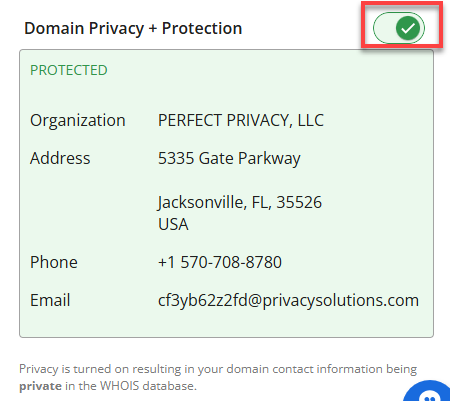
- Read the disclaimer in the Turn Off Private Registration pop-up, check the agree box, and click the Turn Off button to save your changes.

It may take some time for domain setting updates to be reflected entirely in our systems.
What Happens When You Edit Domain Contact Information?
- A Registration Data Directory Services (RDDS) email is sent for confirmation.
- A 60-day transfer lock may be applied to prevent unauthorized transfers.
- Some registrars may temporarily hold updates for security verification.
Understanding COR Lock and Other Domain Locks
What is a COR Lock?
A Change of Registrant (COR) lock is a security feature that prevents unauthorized domain transfers after registrant information updates. It applies a 60-day transfer lock.
How to Unlock a COR Lock
- Some registrars allow opting out before submitting changes.
- If locked, the customer must wait 60 days.
Other Locks That May Occur
- Transfer Lock: Prevents transfers after contact updates.
- Registrar Lock: Requires manual removal by the registrar.
- ICANN Hold: The domain may be suspended if Registration Data Directory Services (RDDS) verification isn't completed in 15 days.
We use various locks on domain names to prevent accidental or malicious transfers and changes that could disrupt associated services or products. For more details, check out the article on The Different Types of Domain Locks.
Summary
Managing domain contacts is crucial for ownership verification, security, and compliance. To secure their information, you should update contact details promptly and enable domain privacy protection. Changes may trigger Registration Data Directory Services (RDDS) verification emails and domain transfer locks, ensuring domains remain protected.
If you need further assistance, feel free to contact us via Chat or Phone:
- Chat Support - While on our website, you should see a CHAT bubble in the bottom right-hand corner of the page. Click anywhere on the bubble to begin a chat session.
- Phone Support -
- US: 888-401-4678
- International: +1 801-765-9400
You may also refer to our Knowledge Base articles to help answer common questions and guide you through various setup, configuration, and troubleshooting steps.